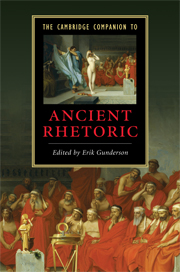Book contents
- Frontmatter
- Introduction
- Part 1 An archaeology of rhetoric
- Part II The field of language
- 4 Divisions of speech
- 5 Rhetoric, aesthetics, and the voice
- 6 The rhetoric of rhetorical theory
- 7 The politics of rhetorical education
- Part III The practice of rhetoric
- Part IV Epilogoues
- Appendix 1: Rhetorical terms
- Appendix 2: Authors and prominent individuals
- References
- Index of passages
- Index of subjects
- Series list
4 - Divisions of speech
from Part II - The field of language
Published online by Cambridge University Press: 28 January 2010
- Frontmatter
- Introduction
- Part 1 An archaeology of rhetoric
- Part II The field of language
- 4 Divisions of speech
- 5 Rhetoric, aesthetics, and the voice
- 6 The rhetoric of rhetorical theory
- 7 The politics of rhetorical education
- Part III The practice of rhetoric
- Part IV Epilogoues
- Appendix 1: Rhetorical terms
- Appendix 2: Authors and prominent individuals
- References
- Index of passages
- Index of subjects
- Series list
Summary
Rhetoric is, above all, a system which offers the prospect of organizing and classifying the apparently limitless variety of human speech. In turn, there are different ways in which one can understand the system of rhetoric, and other chapters in this Companion approach the issue through the different categories of speech that are established or the processes by which rhetoric takes shape in the writings of different theorists. The concern in this chapter is with the divisions within rhetoric itself, which are used to structure both its theoretical treatments and its educational practices: it offers an overview of rhetoric as a system, a dazzling, and at times baffling, elaboration of the process of public speaking developed over centuries.
The level of detail involved in treating structures comprehensively offers great scope for individual writers on rhetoric to create their own distinctive approach and, in consequence, their appeal as teachers, by choosing which areas to emphasize and elaborate upon. Moreover, the level of elaboration varies from one area of rhetoric to another; by concentrating on areas of particular contestation, we can see how the increasing subdivision of rhetorical theory marks out areas of authority and anxiety in the practice of oratory.
- Type
- Chapter
- Information
- The Cambridge Companion to Ancient Rhetoric , pp. 77 - 91Publisher: Cambridge University PressPrint publication year: 2009
- 5
- Cited by

